完整高中英语时态语态讲解及习题
高中英语动词时态练习题及讲解
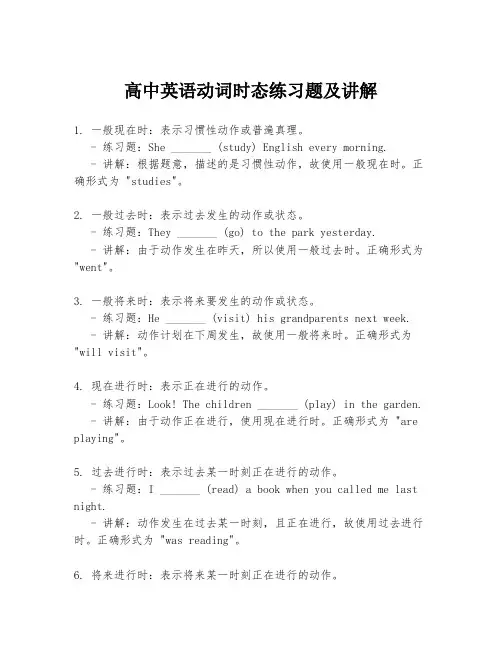
高中英语动词时态练习题及讲解1. 一般现在时:表示习惯性动作或普遍真理。
- 练习题:She _______ (study) English every morning.- 讲解:根据题意,描述的是习惯性动作,故使用一般现在时。
正确形式为 "studies"。
2. 一般过去时:表示过去发生的动作或状态。
- 练习题:They _______ (go) to the park yesterday.- 讲解:由于动作发生在昨天,所以使用一般过去时。
正确形式为"went"。
3. 一般将来时:表示将来要发生的动作或状态。
- 练习题:He _______ (visit) his grandparents next week. - 讲解:动作计划在下周发生,故使用一般将来时。
正确形式为"will visit"。
4. 现在进行时:表示正在进行的动作。
- 练习题:Look! The children _______ (play) in the garden. - 讲解:由于动作正在进行,使用现在进行时。
正确形式为 "are playing"。
5. 过去进行时:表示过去某一时刻正在进行的动作。
- 练习题:I _______ (read) a book when you called me last night.- 讲解:动作发生在过去某一时刻,且正在进行,故使用过去进行时。
正确形式为 "was reading"。
6. 将来进行时:表示将来某一时刻正在进行的动作。
- 练习题:She _______ (be) at a meeting at this time tomorrow.- 讲解:动作将在将来某一时刻进行,使用将来进行时。
正确形式为 "will be"。
7. 现在完成时:表示过去发生的动作对现在有影响或结果。
高中英语时态语态专题-----现在完成进行时讲解和练习

现在完成进行时一、含义:表示一个在过去发生,并持续到现在的动作(这动作可能刚停止,也可能还在进行);用于表达事件的持续性。
由于现在完成进行时是完成体和进行体的组合,所以它同时具备完成时和进行时的特征。
二、结构have/has been doing三、用法1、延续:表示开始于过去的活动持续到现在,并且活动往往还没有结束,将继续持续下去。
The Chinese have been making paper for two thousand years.中国有两千年的造纸历史。
(还将继续造纸,不会停止造纸)。
——Why, Jack, you look so tired! Jack你看上去很累啊!——Well, I have been painting the house and I must finish the work tomorrow.对,我一直在粉刷屋子,而且明天必须得刷完。
(强调一直在做,并且还将持续)【典型例题】Mary_______ to writing classes every night since June and the course will end this week.A. had goneB. has been goingC. is goingD. went【答案】B【解析】考查时态。
句意:从6月开始,玛丽每天晚上去上写作课,这个课程将于这周末结束。
玛丽上写作课的动作从过去持续到未来的这周末,所以要用现在完成进行时。
故选B。
现在完成进行时表示动作从某一时间开始,一直持续到现在,或者刚刚终止,或者可能仍然要继续下去。
2、重复:到目前为止的一段时间内重复发生的活动。
——Isn’t it hard to drive to downtown to work? 开车去市中心上班难道不麻烦吗?——Yes, that’s why I have been going to work by train.很麻烦,这也是为什么我一直坐火车去工作的原因。
高考英语动词时态语态复习题附答案完整版.doc
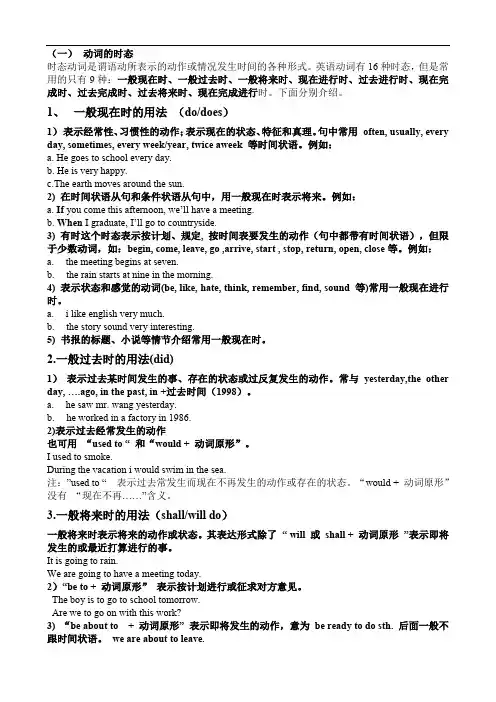
(一)动词的时态时态动词是谓语动所表示的动作或情况发生时间的各种形式。
英语动词有16种时态,但是常用的只有9种:一般现在时、一般过去时、一般将来时、现在进行时、过去进行时、现在完成时、过去完成时、过去将来时、现在完成进行时。
下面分别介绍。
1、一般现在时的用法(do/does)1)表示经常性、习惯性的动作;表示现在的状态、特征和真理。
句中常用often, usually, every day, sometimes, every week/year, twice aweek 等时间状语。
例如:a. He goes to school every day.b. He is very happy.c.The earth moves around the sun.2) 在时间状语从句和条件状语从句中,用一般现在时表示将来。
例如:a. If you come this afternoon, we’ll have a meeting.b. When I graduate, I’ll go to countryside.3) 有时这个时态表示按计划、规定, 按时间表要发生的动作(句中都带有时间状语),但限于少数动词,如:begin, come, leave, go ,arrive, start , stop, return, open, close等。
例如:a.the meeting begins at seven.b.the rain starts at nine in the morning.4) 表示状态和感觉的动词(be, like, hate, think, remember, find, sound 等)常用一般现在进行时。
a.i like english very much.b.the story sound very interesting.5) 书报的标题、小说等情节介绍常用一般现在时。
2.一般过去时的用法(did)1)表示过去某时间发生的事、存在的状态或过反复发生的动作。
高中英语动词时态语态精讲及练习
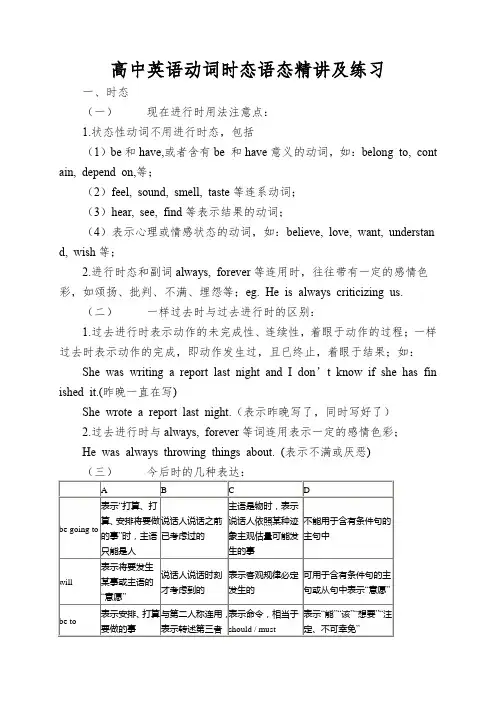
高中英语动词时态语态精讲及练习一、时态(一)现在进行时用法注意点:1.状态性动词不用进行时态,包括(1)be和have,或者含有be 和have意义的动词,如:belong to, cont ain, depend on,等;(2)feel, sound, smell, taste等连系动词;(3)hear, see, find等表示结果的动词;(4)表示心理或情感状态的动词,如:believe, love, want, understan d, wish等;2.进行时态和副词always, forever等连用时,往往带有一定的感情色彩,如颂扬、批判、不满、埋怨等;eg. He is always criticizing us.(二)一样过去时与过去进行时的区别:1.过去进行时表示动作的未完成性、连续性,着眼于动作的过程;一样过去时表示动作的完成,即动作发生过,且已终止,着眼于结果;如:She was writing a report last night and I don’t know if she has fin ished it.(昨晚一直在写)She wrote a report last night.(表示昨晚写了,同时写好了)2.过去进行时与always, forever等词连用表示一定的感情色彩;He was always throwing things about. (表示不满或厌恶)(三)今后时的几种表达:还可用一样现在时、现在进行时表示今后发生的动作;(四)今后进行时与今后完成时:1.今后进行时表示今后某一时刻发生的动作,结构为:will / shall be doing2.今后完成时表示到今后某时刻某动作已发生,结构为:will / shall h ave done,时刻状语为:by+表今后时刻的词语;如:I’ll be climbing the mountain this time the day after tomorrow.By the time he graduates from the college, he will have learned thre e foreign languages.(五)现在完成时及过去完成时的用法注意点:1.瞬时性动词与连续性动词的正确使用:与how long, for, since等表示一段时刻的状语连用时须用连续性动词,如:die-be dead, marry-be ma rried, begin-be on, begin to know-know等;2.注意have been to与have gone to的区别;4.by+过去时刻状语用过去完成时;5.有些动词的过去完成时表示过去未曾实现的意图、打算或期望,这类动词为:think, plan, mean, intend, hope, expect, suppose等;I had intended to visit you yesterday, but the rain prevented me.(六)现在/过去完成进行时的用法:强调动作连续到说话时且还在进行;结构:have (has) / had been doing比较:They have repaired the road.(表示路已修好)They have been repairing the road. (表示路还在修)有时两者可替换:She has taught in this middle school for ten years.She has been teaching in this sch ool for ten years.注意:完成进行时不可与瞬时性动词连用,如:finish, go, marry等;(七)某些固定句型中时态是固定的:1.This / That / It is the first time +从句(用现在完成时)2.It’s / has been +一段时刻+since从句(用过去时)3.It will be +一段时刻+before从句(用一样现在时)/ It was +一段时刻+before从句(用过去时)4. It’s time+从句(用过去时或should do)5.would rather+从句(用一样过去时/过去完成时)It’s getting late. I’d rather you took a taxi there.The film was boring. I’d rather I hadn’t gone to see it.二、语态语态概述英语的语态是通过动词形式的变化表现出来的。
高中英语时态语态专题加练习-附答案
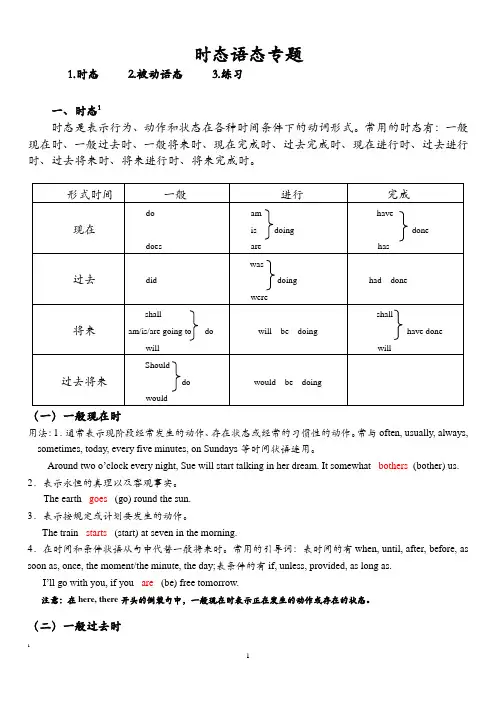
时态语态专题1.时态2.被动语态3.练习一、时态1时态是表示行为、动作和状态在各种时间条件下的动词形式。
常用的时态有:一般现在时、一般过去时、一般将来时、现在完成时、过去完成时、现在进行时、过去进行时、过去将来时、将来进行时、将来完成时。
用法:1.通常表示现阶段经常发生的动作、存在状态或经常的习惯性的动作。
常与often, usually, always, sometimes, today, every five minutes, on Sundays等时间状语连用。
Around two o’clock every night, Sue will start talking in her dream. It somewhat _bothers_(bother) us. 2.表示永恒的真理以及客观事实。
The earth _goes_ (go) round the sun.3.表示按规定或计划要发生的动作。
The train _starts_ (start) at seven in the morning.4.在时间和条件状语从句中代替一般将来时。
常用的引导词:表时间的有when, until, after, before, as soon as, once, the moment/the minute, the day;表条件的有if, unless, provided, as long as.I’ll go with you, if you _are_ (be) free tomorrow.注意:在here, there开头的倒装句中,一般现在时表示正在发生的动作或存在的状态。
(二)一般过去时11.表示在过去某个时间发生的动作或存在的状态。
常与表示过去的时间状语ago, yesterday , last week, in the old days ,when I was five years old, in 1995 等连用。
完整版考点详解版高中英语动词时态语态讲解及练习.doc
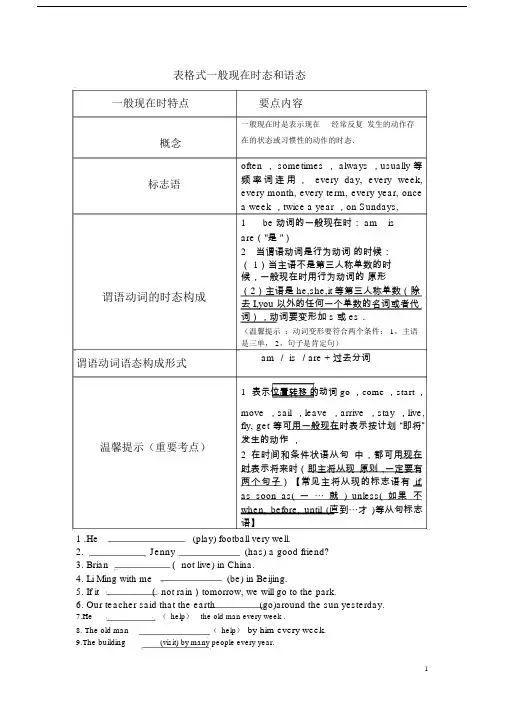
表格式一般现在时态和语态一般现在时特点要点内容一般现在时是表示现在经常反复发生的动作存概念标志语谓语动词的时态构成谓语动词语态构成形式温馨提示(重要考点)在的状态或习惯性的动作的时态.often , sometimes , always ,usually 等频率词连用,every day, every week, every month, every term, every year, once a week ,twice a year ,on Sundays,1be 动词的一般现在时:am isare("是 ")2当谓语动词是行为动词的时候:( 1)当主语不是第三人称单数的时候,一般现在时用行为动词的原形(2)主语是 he,she,it等第三人称单数(除去 I,you 以外的任何一个单数的名词或者代词),动词要变形加 s 或 es.(温馨提示:动词变形要符合两个条件: 1,主语是三单, 2,句子是肯定句)am / is /are + 过去分词1表示位置转移的动词 go ,come ,start ,move ,sail ,leave ,arrive ,stay ,live, fly, get 等可用一般现在时表示按计划“即将”发生的动作,2 在时间和条件状语从句中,都可用现在时表示将来时(即主将从现原则 ,一定要有两个句子)【常见主将从现的标志语有if, as soon as( 一⋯就) unless( 如果不when, before, until (直到⋯才)等从句标志语】1 .He (play) football very well.2. Jenny (has) a good friend?3. Brian ( not live) in China.4. Li Ming with me (be) in Beijing.5. If it ( not rain)tomorrow, we will go to the park.6. Our teacher said that the earth (go)around the sun yesterday.7.He(help)the old man every week .8. The old man(help)by him every week.9.The building(visit) by many people every year.一一般现在时(一)定义:主要用来表示人、事物的现在状况和特点;表示经常或习惯性的动作,句子中常有often, always, from time to time等时间状语;表示客观规律和永恒真理等He usually goes to work at 7 o ’clock every morning.The earth goes around the sun. Guangzhou is situated in the south of China.(二)标志词:always, usually, often, sometimes, hardly ever ,every week (day, year, month ⋯ ),once /twice a week, on Sundays,(三)谓语动词构成:1be 动词的一般现在时:am is are("是",“在”)2当谓语动词是行为动词的时候:( 1)当主语不是第三人称单数的时候,一般现在时用行为动词的原形(2)主语是 he,she,it 等第三人称单数(除去 I,you 以外的任何一个单数的名词或者代词),动词要变形加 s 或 es.(温馨提示:动词变形要符合两个条件:1,主语是三单,2,句子是肯定句)(四) .基本结构:1,肯定句:主语+谓语( +其他的)He loves sports.Jane is an outgoing girl.(主语 He 是三单,又是肯定句,所以谓语动词发生变形,加上了s)Tom and Tim both have medium height.He has a big mouth.We like the dog very much.2,否定句:主语+don’t或者doesn’t+动词原形+其他(在 be 或者后面加上do does) Candy doesn’t do her housework every day.We don’t dance .He isn’t a worker.3,一般疑问句:Do (Does)+ 主语 +动词原形 +其他?(把be 或者 do does 提到主语的前面)Does she like English? Yes,she does.No,she doesn’t.Do you swim in summer?Are you a teacher?4,特殊疑问句:疑问词+一般疑问句Where does Tom come from?(五 )一般现在时态用法(1)经常性或习惯性的动作,常与这样的时间状语连用:eg: We always help each other.It often snows in winter. I get up early every morning.(2)表示主语现在的特征、性格、能力等。
高中英语时态及练习
高中英语时态及练习一、一般现在时1、表示现在发生的动作或存在的状态,常与every day,once a week,in the morning,at present等连用。
例:They don’t usually have enough money to go to the movies.2、表示主语具备的性格和能力等。
例:Mary can speak three languages.3、表示经常性或习惯性的动作,常与always,never,sometimes,often等连用。
例:I never eat fast food.4、表示现在提出的建议或要求。
例:Could you please help me with my math homework?二、现在进行时1、表示正在发生的动作或存在的状态。
例:He is studying for his history exam.2、表示现阶段正在进行的动作,但这个动作不一定正在进行。
例:My brother is preparing for his college entrance exams.3、表示即将发生的动作,常与表示将来的时间副词连用。
例:We are about to start our journey.三、现在完成时1、表示过去发生的动作对现在造成的结果。
例:I have just finished my homework.2、表示过去开始一直持续到现在的动作或状态,并可能继续下去。
例:They have been married for 20 years.四、一般过去时1、表示过去某个时间发生的动作或存在的状态。
例:We saw a movie last night.2、表示过去经常或反复发生的动作。
例:He always went to the park in the morning.高中英语时态练习英语时态是英语语法中非常重要的一个部分,也是我们在学习英语过程中必须要掌握的知识。
时态语态高中练习题及讲解
时态语态高中练习题及讲解### 时态语态高中练习题及讲解#### 练习题1. 一般现在时:请用一般现在时翻译下列句子。
- 他每天早晨跑步。
- 地球绕着太阳转。
2. 一般过去时:将下列句子转换为一般过去时。
- 我昨天去了图书馆。
- 他们去年在这个城市买了房子。
3. 一般将来时:使用一般将来时构造以下句子。
- 明天我会去看电影。
- 她下个月将会参加一个会议。
4. 现在进行时:根据给定的动词,构造现在进行时的句子。
- 她正在学习。
- 他们正在讨论。
5. 过去进行时:将下列句子转换为过去进行时。
- 昨天这个时候,我正在看电视。
- 昨晚,他们正在准备晚餐。
6. 现在完成时:使用现在完成时描述以下情况。
- 我已经完成了我的作业。
- 他们还没有到达。
7. 过去完成时:构造过去完成时的句子。
- 我到达的时候,电影已经开始了。
- 她告诉我她已经完成了她的报告。
8. 被动语态:将下列句子转换为被动语态。
- 他们正在建造一座新桥。
- 这本书是由著名作家写的。
9. 情态动词:使用情态动词表达可能性或能力。
- 他可能已经离开了。
- 她能够解决这个问题。
10. 条件句:构造条件句。
- 如果明天下雨,我们就不去野餐了。
- 要是我有时间,我会去参观博物馆。
#### 讲解1. 一般现在时:用来描述经常发生的动作或状态,以及普遍真理。
- He runs every morning.- The Earth revolves around the Sun.2. 一般过去时:用来描述过去发生的动作或状态。
- I went to the library yesterday.- They bought a house in this city last year.3. 一般将来时:用来描述将要发生的动作或状态。
- I will go to the movies tomorrow.- She will attend a meeting next month.4. 现在进行时:用来描述正在发生的动作。
高中英语高考语法时态语态讲与练
高中英语高考语法动词时态语态讲与练★★★动词的时态★★★★ (1) 一般现在时A.BE动词:现在的情况或状态。
如:职业,年龄,高矮,地点等。
There be 句型。
主语+ be (am/ is/ are)……I am……………………You are………………He/She/It is…………We/You/They are……There is/are…………I amWeYou are a doctor/tall/short. You are doctors/tall/short.He/She is TheyI am WeYou are seventeen (years old). You are ninety (years old).He/She is TheyI am WeYou are beside the machine. You are under the bridge.He/She is TheyI amYou areHe/She is busy/free/ill/well nowWe areThey areB. HAVE 动词:某人/某物现在有什么。
I have………………….. 1)I have 4 dollars on/with/about me.He/She/It has………….. 2)He has six sisters.We/You/They have……. 3)You have eight magazines now.C. DO 动词:经常性、习惯性、规律性、真理性或者反复发生的动作。
(爱好、居住、讲/懂语言、自然现象、谚语格言、客观事实或真理等也用此时态。
)与一般现在时连用的词或短语有:always, often, usually, every, sometimes, seldom, never,rarely, hardly, frequently, occasionally, (every) now and then, at times, from time totime,on Mondays/Tuesdays/Thursdays/Fridays/Saturdays/Sundays (每周星期一/二/四/五/六/天),once/twice/three times a day(week/month/year)【一天(周/月/年)一次(两次/三次)】,every few days/weeks/months/years, every other day/week/month/year主语(I/We/You/They)+ 动词原形主语(He/She/It)+ S动词●动词原形→第三人称单数一般现在时动词:(a)一般情况:加s ; attracts rejects pollutes sweeps writes(b) s,x,ch, sh结尾:加es ; passes fixes matches finishes(c)辅音字母+ y结尾:先变y为i, 再加es ; study – studies carry -- carries(d)特殊变法:do → does have → has go → goes1)I/You/We/They have maths every day.2)He/She has maths every day.3)The students usually get up at 6:50 in the morning.4)The boy usually gets up at 6:50 in the morning.5)We go to the forest for our holidays now and then.6)She goes to the forest for her holidays now and then.15) Yesterday the geography teacher explained to us that the sun rises from the east.●表示“计划,安排,规定”时,常用一般现在时表示将来时。
高中英语时态语态讲解及习题
时态与语态一.一般现在时,表示现在经常性、习惯性的动作和状态,常见的时间状语包括sometimes, often, usually, always,occasionally, now and then,on weekends,onSundays,every week/month/year等She always takes a walk in the evening.He often does his homework in his study.1.一般现在时表示客观真理、科学事实及自然现象和谚语格言中,此用法即使出现在过去语境中,也用一般现在时。
The moon goes around the earth.Pride goes before a fall.骄者必败He said the earth is round.2.主句是一般将来时,由when,after, before, as soon as, the minute,whenever等引导的时间状语和由if, unless, so long as, once等引导的条件状语和however,even if等引导的让步状语从句中一般用一般现在时表示将来。
如:l’ll go there after I finish my work.If it rains tomorrow,I won’t go there.I will tell her when she comes tomorrow.Even if it rains tomorrow, the sports meeting will take place.3.在以here,there开头的句子里,go,come等少数动词的一般在时表示正在发生的动作。
例如:There goes the bell.铃响了。
There comes the bus.汽车来了。
Here she comes.她来了。
4. But for the fact that…从句中,that 从句的谓语动词时态要根据句子谓语所表示的时间而定。
- 1、下载文档前请自行甄别文档内容的完整性,平台不提供额外的编辑、内容补充、找答案等附加服务。
- 2、"仅部分预览"的文档,不可在线预览部分如存在完整性等问题,可反馈申请退款(可完整预览的文档不适用该条件!)。
- 3、如文档侵犯您的权益,请联系客服反馈,我们会尽快为您处理(人工客服工作时间:9:00-18:30)。
时态与语态一.一般现在时,表示现在经常性、习惯性的动作和状态,常见的时间状语包括sometimes, often, usually, always,occasionally, now and then,on weekends,onSundays,every week/month/year等She always takes a walk in the evening.He often does his homework in his study.1.一般现在时表示客观真理、科学事实及自然现象和谚语格言中,此用法即使出现在过去语境中,也用一般现在时。
The moon goes around the earth.Pride goes before a fall.骄者必败He said the earth is round.2.主句是一般将来时,由when,after, before, as soon as, the minute,whenever 等引导的时间状语和由if, unless, so long as, once等引导的条件状语和however,even if 等引导的让步状语从句中一般用一般现在时表示将来。
如:l'll go there after I finish my work.If it rains tomorrow,I won't go there.I will tell her when she comes tomorrow.Even if it rains tomorrow, the sports meeting will take place.3.在以here,there开头的句子里,go,come等少数动词的一般在时表示正在发生的动作。
例如:There goes the bell.铃响了。
There comes the bus.汽车来了。
Here she comes.她来了。
4. But for the fact that…从句中,that 从句的谓语动词时态要根据句子谓语所表示的时间而定。
But for the fact that he is busy now, he would be here.But for the fact that you were ill, I would have had you print the papers.二、一般过去时表示过去的经常性、习惯性的动作或状态或者某个人过去的经历,与现在无关,常用的时间状语有yesterday, the day before yesterday, an hour ago, the other day, lastmonth/year, just now, in 1982, in the old days, in the past, when I was young, when I was inLondon,when I was a child等I received two letters last week.The Olympic Games were held in Beijing in 2008.When I was in Beijing, I often went to Beijing university.1.表示某人过去的经历1) ---- Have you graduated from the university?----- Yes, I learned English for 4 years in the university.12) ---- Have you finished your homework ?----- Yes, I ________(finish) it within hald an hour.3) I ______(be) in London for 10 years, but I have never regretted returning to China.2. intend, wonder, think, realize等用过去时,表示说话人原来没有料到,打算,想到等I thought you were a student.I didn't think /realize you failed again.I didn't intend to hurt you.3. used to do sth/ would do sth 过去常常做某事We used to spend our vacation in the mountains4.句型1).It is (high) time sb did sth/ It is time that sb should do sth.某人该干某事了。
It is time you went to bed.2) .Would rather sb did sth 宁愿某人做某事,用于对现在和将来时间的虚拟。
I would rather you came tomorrow/now.3). Would/ should/ ought to/ could/ might/ needn't/ would like to have done sth, but…句型中,but 后面的谓语动词需用一般过去时或过去进行时。
a. He should have turned up but he had an unexpected visitor.b. --- Did you attend the party?---- I would have(attended the party) but I was busy.= I was busy otherwise/or I would have attended the party.= I had planned to attend the party but I was busy.= I was going to attend the party, but I was busy.4). Would you mind if sb did sth? 如果…干某事,你介意吗?Would you mind if I opened the door?三.一般将来时/过去将来时一般将来时表示将来要发生的动作和存在的状况。
常见的时间状语有next…, tomorrow, the day after tomorrow, in+时间段,before+ 时间点,in the future等.1.will/shall do sth1)表示事物的固有属性或者必然的趋势;Fish will die without water.2) will 表示将来,有时含偶然性和临时性决定的意思。
---- Do you know Mr. Smith has come to our town?---- No, I will go and visit him right now.2.be going to do sth1)表示事先考虑过,计划打算做某事,注意区分一下will 表示临时性决定的用法。
He is going to speak on Tv this evening.2)表示根据现在的迹象对未来进行推断。
Look at the dark clouds. It is going to rain.表示过去本打算做某事,但未做注意:was going to----Tom, you didn't come to the party last night?2---- I was going to, but I suddenly remembered I had homework to do.3.be doing sth 有些动词如come, go, arrive,leave,begin, start, return等,其现在进行时表示按计划、安排近期将要发生的动作。
I'm leaving for Beijing next month.4.be about to do sth/ be on the point of doing sth (when) “即将干某事(这是突然)…”该结构不与具体的时间状语连用,但可以和并列连词when连用。
The train is about to start.The plan is on the point of taking off.5. 某些动词的一般现在时可以表示计划、安排将要做的事情,此种用法常常用于火车时刻、飞机时刻、电影开演、作息安排等时刻表上。
We must hurry up. The first class begins at 8 o'clock.The train leaves at 5 and arrives at 8.6.be to do sth1).表示按计划或安排要做的事She is to get married next month.注意:were/was to have done sth 表示未曾实现的计划。
We were to have told you, but you were not in.2) 表示“应该”,相当于should, ought to.You are to report it to the police.3) 表示“想,打算”, 相当于intend, want.If we are to be there before ten, we'll have to go now.四.现在进行时 am/is /are doing sth表示说话时正在发生的动作,有时也表示一段时间内持续进行的动作,常见的时间状语为: now, at present, these days等I am writing a novel these days.I'm doing a word puzzle in this newspaper.1)与always, constantly, continually, forever, all the time 等连用,带有厌恶、批评、不喜欢、赞扬等感情色彩。
You are always putting your things around.He is always helping others.2) 下列四类动词一般不用现在进行时感觉类:look, smell, feel, sound, taste,see, hear等The soup tastes good.情感类:like,love, prefer, admire, hate, fear, adore等I love my dad and mum.心态类:wish. Hope, want, need, believe, understand, agree, know, remember,forget 等I don't believe my eyes.3存在状态类:appear, lie, remain, belong, have 等Those books belong to Mr. Li.3) 延续性动作用进行体,短暂性动作用一般体,一个延续性动作为背景,被一个短暂性动作打断My brother fell while he was riding his bike and hurt himself.As she was reading the newspaper, Granny fell asleep.五.过去进行时 was/were doing sth表示过去某一时间或某一段时间内正在进行的动作。
